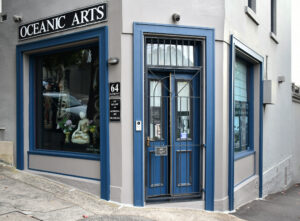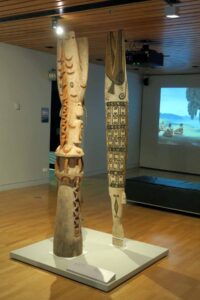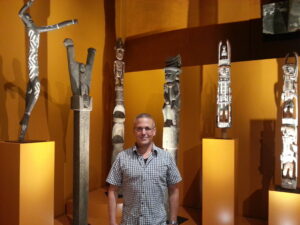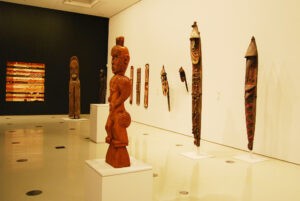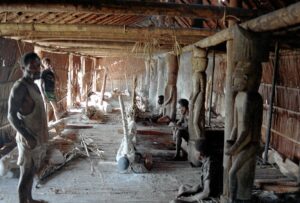Oceanic Art Society Todd Barlin Interview by Margaret Cassidy 2020
| Collection No. | N/A |
|---|---|
| Size | N/A |
Oceanic Art Society Todd Barlin Interview by Margaret Cassidy 2020
Down a quiet tree-lined street in inner-city Paddington sits the last remaining physical gallery in New South Wales devoted solely to the art of Australia’s Pacific Island neighbours. Long time resident and foundation member of the Oceanic Art Society Todd Barlin runs the Oceanic Arts Australia gallery with the help of his much loved life partner Vincent Ro.
As a serious collector of rocks, shells, stamps, insects, old glass bottles and later ceramics from Mexico and South America from an early age growing up on farms in California, Todd was fascinated by the imported Mexican pottery sold at the business where his mother worked and had an interest in indigenous people since he was a boy travelling with her to Mexico, watching the workers fire their wood kilns and then buying the pottery the following day, and seeing “how the people lived and were so happy though they had so little materially.”
In 1985 Todd travelled via New Zealand to Australia, first seeing Oceanic Art at the Auckland Museum where he was “overwhelmed by the beauty and magic of the artworks from the Pacific Islands”. After arriving in Australia, a friend suggested that he should see the people and artists in person; so within the calendar year Todd had travelled to New Guinea for two months and then in West Papua for two months. As Todd has said, “This was advice that changed my life forever. That two month trip to the New Guinea Highlands and the Sepik River was transformative. I was overwhelmed by the kindness and warmth of the people and how happy and confident they were in their day to day lives.”
Todd’s first trip to Papua New Guinea ignited his lifelong interest and interaction with Pacific People; their Art and their Culture, leading to him making over 40 trips over the next 25 years to Papua New Guinea, Indonesian West Papua, Vanuatu and The Solomon Islands. Todd has described these early experiences, “I would stay in remote villages for days, weeks and even months at a time. It was a chance to get to know people and let them get to know you. I lived as they did, ate what they had each day and also suffered problems such as malaria and dengue fever. Despite the fortuitous and unpredictable circumstances, this was a magical pre-digital era – before the internet, mobile phones or television exposed remote villages to the outside world. I often stayed for six to eight months a year travelling in remote areas and for that time it was as if the rest of the world did not exist.”
Inspired by his year in Oceania and his voluntary position at the Macleay Museum in 1986-87, Todd returned to the United States and started his art business. However, the magic of the people and their artworks of the South Pacific didn’t pall and in 1987 Todd applied to migrate to Australia. He returned, spending time as a volunteer at The Australia Museum, which gave him experience of museums but also the chance to see thousands of Oceanic artworks. From 1988 – 1994 he ran his first gallery from his suburban home in Sydney’s Inner West and a warehouse nearby. He was away most of the time in New Guinea and West Papua and in 1991 Robert Bleakley at Sotheby’s recognised the expertise and passion in Todd for oceanic art and culture and hired him as their Tribal Art Expert where he stayed for 5 years.
Talking to Todd about his career, it is clear that he has been a ‘giver’ all of his life, that the things he is most proud of are the artworks that he has been able to source for public museums and galleries and the money that he has been able to donate to support indigenous education in Australia through the Australian Indigenous Education Fund (AIEF) and other charities that have supported indigenous people in developing countries, these are two things I am very proud of.”
Todd played a pivotal role in bringing particularly New Guinean and West Papuan cultures to international audiences around the millennium. He provided the field documentation and artworks for several important exhibitions, The Asmat & Mimika in 1996 and The Marind Anim in 1999, both at the Musée National des Arts d’Afrique et d’Océanie in Paris, now all moved to the new Musée du Quai Branly – Jacques Chirac. As Todd recounts, “now when you walk into the Oceanic Art Pavilion at the Quai Branly, the first things you see are the monumental ancestor poles from the Asmat and Mimika along with a four metre long Asmat soul canoe, dance costumes and shields all which I field collected in the 1980s”. Another highlight of Todd’s career was the support he provided to the Oceanic Art Society’s ambitious contribution to the Sydney Olympic Arts Festival in 2000 with the exhibition of the Monumental Sculptures of West Papua at the Sydney College of the Arts. More recently he worked closely with the Casula Powerhouse Arts Centre for four years from 2010 loaning many items from his collection to support the annual Pacific Collections and Community Engagement programs, complementing contemporary Pacific artists and reiterating an understanding of Pacific cultural heritage to local communities.
As Todd reminisces about his long time love affair with promoting Oceanic Art, “I have had the chance to work with many very dynamic people in the Pacific Arts and Culture Community. I was often lucky to be in the right place at the right time to witness and record preparation for ceremonies, making of artworks and other spiritual practices. I spent many months living with several cultural groups including: the Asmat, the Mimika, The Marind Anim on the South Coast of West Papua and around Lake Sentani, and Geelvink Bay along the North Coast of West Papua. I was also fortunate to spend time in the Sepik River, Southern Highlands and Enga Provinces of Papua New Guinea and also remote villages in Vanuatu and The Solomon Islands.
“Many of the elderly and senior men in the villages were particularly generous to include me in their thoughts about their ancient traditions that seemed to be on the cusp of being lost. They appreciate that I was interested in their culture. They encouraged me to photograph and film in order to help preserve their culture for future generations.” Todd has now donated his photographic archive of over 9000 field photos to The South Australian Museum where he hopes they will be accessed and used by the descendants of the people photographed for years to come.
Todd wasn’t trained in either art history or the practice of art but first came to love and understand Oceanic Art and culture through developing a close relationship with many people in the Pacific, as Todd puts it, “the people in New Guinea were my first love before really understanding the art. The people were so warm, kind, generous with their hospitality.”
He further explains, “our family was poor and the arts were not really available to me when I was growing up; I did get to see some museums on school field trips which were terribly exciting along with National Geographic Magazine which I have been reading for 50 years. However, I have been very fortunate to have had some great Oceanic Art teachers in Sydney including Chris Boylan, Helen Dennett, Geoff Carey & Leo Fleischmann, Harry Beran, Robert Bleakley, Gabriella Roy and others.”
Todd quickly developed a passion for the preservation of culture and history through collecting and documentation. He spent time with communities in the Pacific, collected many objects in the field and then sold some on each return to Australia in order to fund his next collecting trip back into the field, saying, “I became an art dealer so I could collect, travel and spend months staying in remote areas of West Papua and New Guinea.”
When Todd shows pieces in his collection, he is still looking for physical and visual connections between works. As he said, “I collected what I liked visually and what excited and expanded my imagination. I experience artworks in a physical way. The artworks that I like most are inspired by images often made of dreams and are highly abstracted. I also find these qualities in nature; natural formed wood and stone, shells and seed pods, and vines – these are recurring motifs often found in New Guinea Art.”
Having spent extensive time in Pacific communities, he also understands the true place of their creations, he reminds us that “for the people of the Pacific Islands, their artworks are not an ornament to hang on a wall, but are a visual reminder of important ancestors or powerful spirits that guide and protect the people. These ancestors and spirits are always present. They are found in specific locations in the forest or kept in specially made houses where men perform ceremonies to honour or appease them. An ancestor can be invited and embodied into a carved ritual figure, or even a war shield. These carvings would then include a personal name of an ancestor and would be highly respected. “
When pushed to identify his favourite Oceanic Art style or place of origin, Todd struggles to favour any particular artwork, saying “I can’t say I have favourite artworks; every artwork I ever bought was my favourite at the moment and many of the pieces I got in villages from old people who were friends, these have deep meaning because of the friendships. Every area of Oceanic Art has beautiful artworks but I guess my favourites are the abstracted styles of the Kwoma and Nukama People in the Waskuk area along with the Papuan Gulf and the Asmat, I lived with the Asmat for more than two years cumulatively, they are great abstract artists.”

